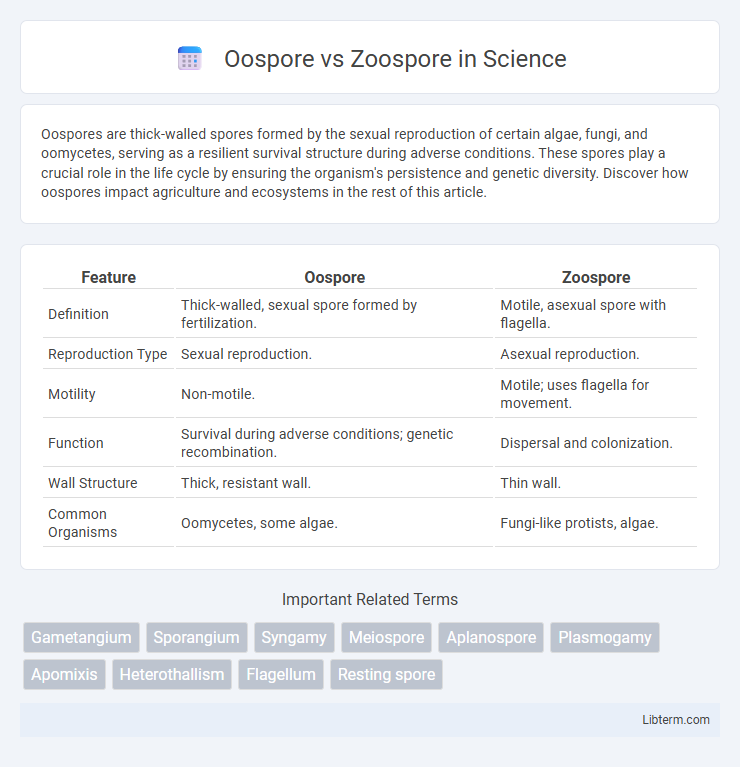Oospores are thick-walled spores formed by the sexual reproduction of certain algae, fungi, and oomycetes, serving as a resilient survival structure during adverse conditions. These spores play a crucial role in the life cycle by ensuring the organism's persistence and genetic diversity. Discover how oospores impact agriculture and ecosystems in the rest of this article.
Table of Comparison
| Feature | Oospore | Zoospore |
|---|---|---|
| Definition | Thick-walled, sexual spore formed by fertilization. | Motile, asexual spore with flagella. |
| Reproduction Type | Sexual reproduction. | Asexual reproduction. |
| Motility | Non-motile. | Motile; uses flagella for movement. |
| Function | Survival during adverse conditions; genetic recombination. | Dispersal and colonization. |
| Wall Structure | Thick, resistant wall. | Thin wall. |
| Common Organisms | Oomycetes, some algae. | Fungi-like protists, algae. |
Introduction to Oospores and Zoospores
Oospores are thick-walled, non-motile spores formed by the sexual reproduction process in certain algae and fungi, providing durability in adverse environmental conditions. Zoospores are motile spores equipped with flagella, enabling active movement in aquatic environments, and are produced asexually to rapidly colonize suitable habitats. Both spore types play crucial roles in the life cycles of oomycetes and other protists, facilitating survival and dispersal.
Definition of Oospore
Oospore is a thick-walled, sexually produced spore formed by the fusion of two gametes in certain algae and fungi, serving as a resistant, dormant structure capable of surviving unfavorable conditions. Zoospore, in contrast, is an asexual, motile spore equipped with flagella, enabling active movement in aquatic environments for dispersal and colonization. Oospores contribute to genetic diversity and long-term survival, while zoospores facilitate rapid propagation in moist habitats.
Definition of Zoospore
A zoospore is a motile asexual spore that uses flagella for movement and is commonly found in certain algae, fungi, and protists. Unlike oospores, which are thick-walled and non-motile sexual spores, zoospores enable rapid dispersal in aquatic or moist environments. Zoospore production is crucial for species that rely on water to transport their spores to new locations.
Formation Process of Oospores
Oospores form through a sexual reproduction process involving the fusion of an oogonium and an antheridium, resulting in a thick-walled, durable spore that ensures survival under adverse conditions. This process includes the development of female gametes inside the oogonium and male gametes in the antheridium, followed by plasmogamy and karyogamy leading to the oospore. Unlike zoospores, which are asexual, motile spores produced by mitosis, oospores are non-motile and arise from meiosis, providing genetic recombination and enhanced resilience.
Formation Process of Zoospores
Zoospores form through a specialized process of mitotic division where a single parent cell develops multiple motile spores equipped with flagella for movement in aquatic environments. Unlike oospores, which result from sexual reproduction involving the fusion of gametes, zoospore formation is strictly asexual, allowing rapid population expansion. This motility provides zoospores with a significant advantage in colonizing new substrates and adapting to changing conditions.
Structural Differences Between Oospore and Zoospore
Oospores are thick-walled, spherical reproductive structures formed by the fusion of gametes in certain algae and fungi, providing durability and resistance during adverse conditions. Zoospores are motile, flagellated spores characterized by one or more flagella that enable locomotion in aquatic environments, facilitating rapid dispersal. Unlike non-motile, dormant oospores, zoospores have a thinner wall and are adapted for active movement rather than long-term survival.
Reproductive Strategies: Oospore vs Zoospore
Oospores and zoospores represent distinct reproductive strategies in fungi and algae, with oospores serving as thick-walled, resistant sexual spores that ensure survival under adverse conditions through genetic recombination. Zoospores are motile asexual spores equipped with flagella, enabling rapid dispersal and colonization in aquatic environments. The contrast between oospore's durability and zoospore's mobility highlights adaptive responses to environmental stability and resource availability.
Ecological Significance of Oospores and Zoospores
Oospores provide ecological resilience by enabling survival during adverse conditions through their thick-walled, dormant structure, ensuring long-term species persistence in fluctuating environments. Zoospores contribute to rapid colonization and dispersion due to their motility, facilitating infection and nutrient cycling in aquatic and soil ecosystems. Together, oospores and zoospores play complementary roles in sustaining pathogen populations and maintaining ecological balance in various habitats.
Examples of Organisms Producing Oospores and Zoospores
Oospores are produced by Oomycetes such as Phytophthora and Pythium species, as well as some green algae like Volvox, serving as thick-walled sexual spores for survival. Zoospores are motile asexual spores found in organisms like Chytrids, certain Oomycetes (e.g., Albugo), and some green algae including Chlamydomonas, characterized by their flagella aiding in aquatic dispersal. These distinct reproductive structures reflect adaptations for reproduction and survival in varying environmental conditions among aquatic and terrestrial protists.
Key Differences Between Oospore and Zoospore
Oospores are thick-walled, non-motile spores resulting from sexual reproduction in oomycetes, whereas zoospores are motile, flagellated spores produced asexually that enable rapid dispersal in aquatic environments. Oospores serve as durable survival structures, enhancing resistance to adverse conditions, while zoospores facilitate quick colonization and infection due to their swimming capability. The genetic recombination in oospores contrasts with the genetic uniformity in zoospores, reflecting their distinct reproductive roles.
Oospore Infographic

 libterm.com
libterm.com